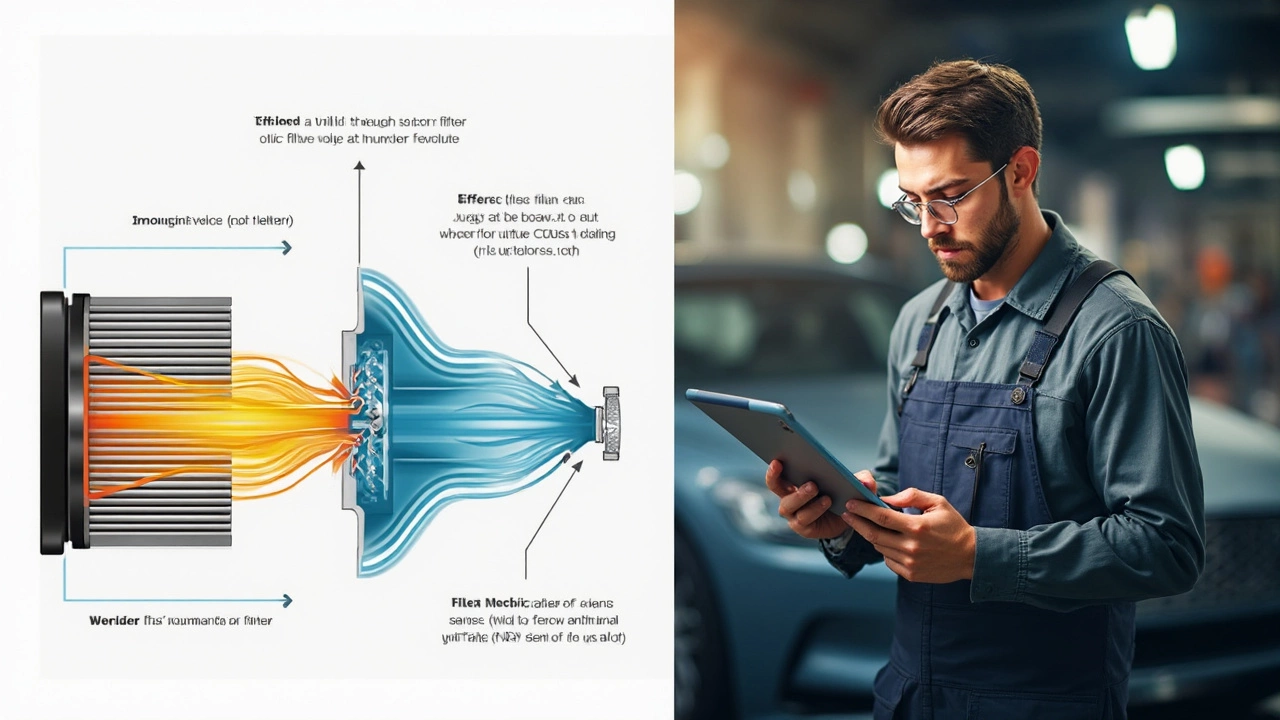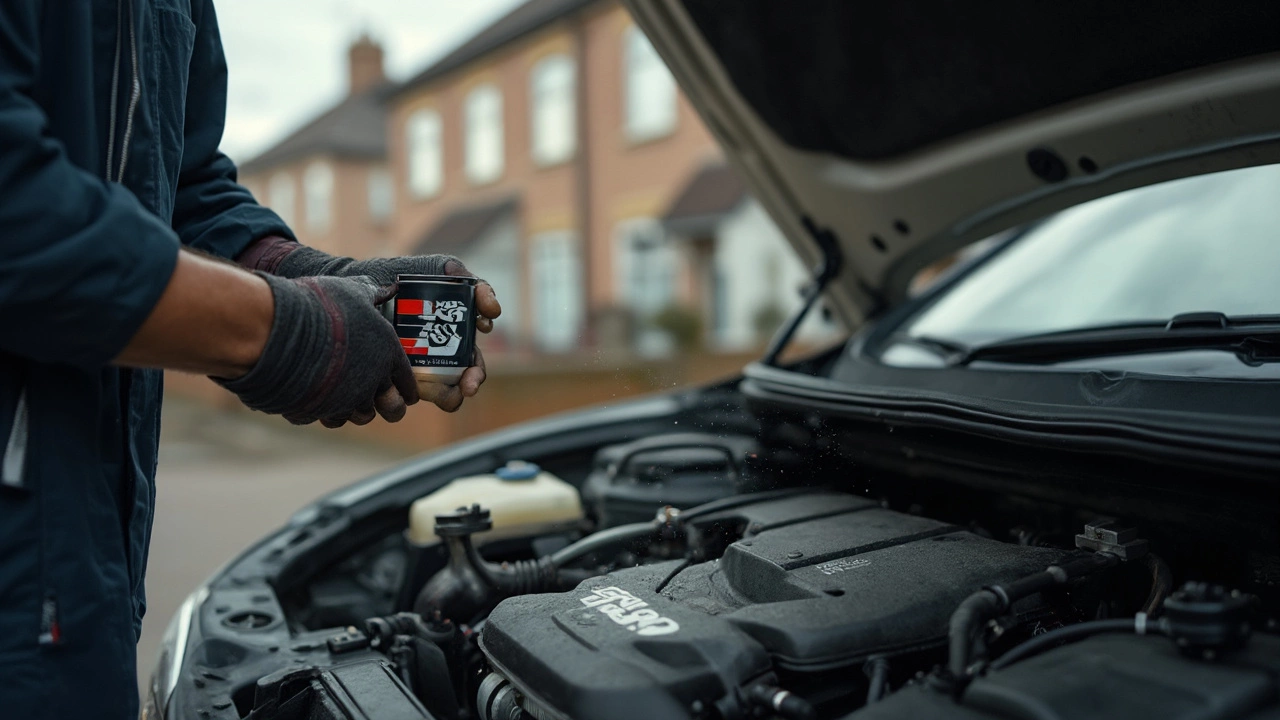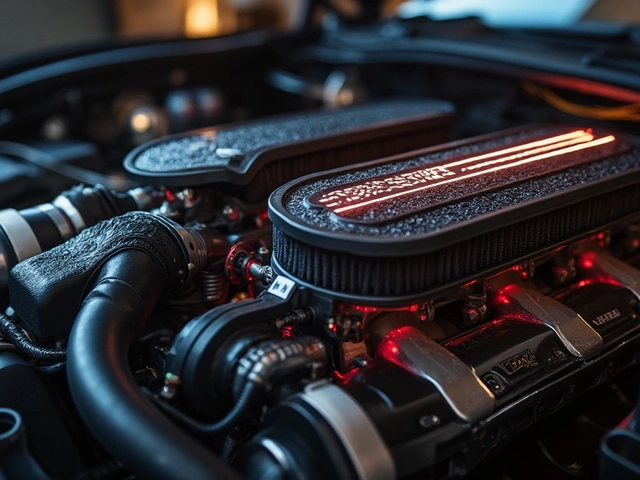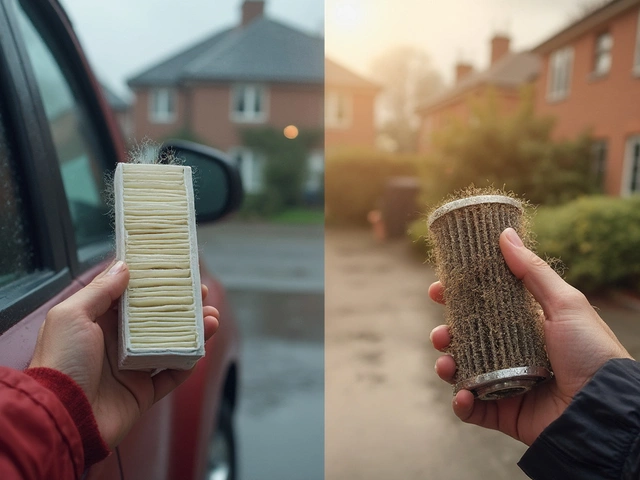There’s a heated debate in car forums: do K&N filters damage your MAF sensor, or are they totally safe if you install them right? Performance fans love K&N for their promise of better airflow and maybe even a little more horsepower, but skeptics claim those oil-soaked filters can wreck sensitive electronics under the hood.
If you’re thinking of putting a K&N in your ride or you already run one, it makes sense to double-check the risks. MAF sensors (that’s mass airflow sensors) are fragile and crucial—if they get sticky or caked in oil, your car might run rough, burn more gas, or even trip a check engine light.
So what’s really going on? Does the oil from a K&N filter get sucked through and end up coating your MAF? Does it happen a lot, or just if you mess up during filter cleaning? It’s not just internet hearsay—some mechanics have seen sensors fouled up by filter oil, while others swear it’s been blown out of proportion.
The truth isn’t as dramatic as the rumors—but it’s not harmless either if you don’t follow a few key steps. Want to keep your MAF happy and still run your performance filter? Let’s dig into how this stuff really works and what you can do to avoid costly mistakes.
- How MAF Sensors Actually Work
- K&N Filters: What Makes Them Different?
- The Oily Truth: Fact or Myth About Sensor Damage
- Real-World Evidence and Case Studies
- How to Prevent Problems With Oiled Filters
- Who Should (and Shouldn’t) Use K&N Filters
How MAF Sensors Actually Work
Your MAF sensor (Mass Air Flow sensor) is like your car’s “lung monitor.” It measures how much air is getting sucked into the engine, so your ECU can deliver just the right amount of fuel. If your numbers are off, your car might stumble, idle rough, or chug more gas than usual.
Most cars today use hot-wire MAF sensors. Here’s the simple breakdown: there’s a thin wire or film inside the sensor that gets heated up electrically. As air passes over it, the air cools the wire down. The sensor keeps that piece at a constant temperature by adjusting the current. More air = more cooling needed = more power sent to the wire. The sensor tracks this and sends the data straight to the engine computer—which then adjusts fuel injection for a perfect mix.
- K&N filters and other performance air filters directly impact the air going past the MAF sensor.
- If the MAF isn’t happy, performance drops—no matter how good your filter is.
When sensors get dirty, mainly from dust, oil, or junk in the intake, their readings get wonky. A fouled MAF might make your car run rich or lean. On some Nissans and Mazdas, a crusty MAF can even kill your throttle response completely. And with modern rides, a check engine light isn’t out of the question.
It’s a sensitive part—just a little bit of gunk can mess with the signal. That’s why performance air filter choices matter. You want cleaner air, but you don’t want anything else sneaking through. Keep the MAF happy, and the rest of your car usually stays happy too.
| Quick MAF Sensor Facts | Details |
|---|---|
| Location | Between the air filter and throttle body |
| Usual Sensor Type | Hot-wire or hot-film |
| Symptoms of a Failing MAF | Poor throttle response, rough idle, high fuel use, check engine light |
K&N Filters: What Makes Them Different?
Alright, so what’s the deal with K&N filters compared to your regular paper air filter? The big selling point is the design. Instead of paper, K&N uses several layers of cotton gauze sandwiched between wire mesh. But here’s the part everybody talks about: these filters are soaked in a special oil. That oil grabs dust, dirt, and other nasty stuff so it doesn’t get sucked into your engine.
This oil coating is what separates K&N (and similar “oiled filters”) from most factory filters. Standard filters are dry—they just rely on the paper or synthetic fiber to catch stuff. K&N’s oil does make it better at catching very small particles while letting in more air. More air can mean more power (in some cars, you’ll pick up a couple of horsepower or see a slight bump in throttle response).
Durability is another plus. While you toss out cheap paper filters and buy new ones, K&N filters are reusable. Just clean and re-oil them every 30,000 to 50,000 miles (or more often if you drive in dusty conditions). K&N claims their filters can go up to a million miles if you keep them clean and oiled right.
Here’s a quick side-by-side:
| Feature | K&N Filter | Standard Filter |
|---|---|---|
| Material | Cotton gauze + oil | Pleated paper |
| Reusable | Yes (wash & re-oil) | No |
| Airflow | High | Moderate |
| Particle Filtration | Very fine (with oil) | Good but less effective for tiny particles |
| Maintenance | Cleaning and oiling required | Replace and forget |
The main catch? Extra airflow and reusable design only work if you maintain that filter the right way. Too much oil—or not enough—can lead to issues (especially with your MAF sensor). So, loving a K&N filter means being willing to get your hands a little dirty every so often.
The Oily Truth: Fact or Myth About Sensor Damage
This is the big question—do K&N filters really ruin your MAF sensor, or is it just car-guy myth? Here’s what we actually know. K&N filters use an oiled cotton design, letting in more air but also needing a special, sticky oil to trap dirt and dust. People worry this oil can end up on the sensor and mess things up. And sometimes? They’re not totally wrong.
Most cases of MAF trouble happen when people go heavy on the oil after cleaning. Over-oiling is the real villain. When you soak the filter with too much oil, some of it can get sucked through and land right on your MAF sensor. Modern sensors are touchy—a thin layer of anything, let alone oil, can throw off readings. That’s when you get rough idle, poor gas mileage, or that dreaded check engine light kicking in.
But let’s get specific. K&N themselves have done tests showing that, when used and oiled properly, their filters don’t release enough oil to cause harm. There’ve been independent tests too. Ford published a tech bulletin years back about contaminated sensors, but lots of cases were traced to folks overdoing it with the oil, not the filter itself being faulty. There’s no clear stat showing that performance air filters automatically kill MAF sensors, but improper oiling can absolutely cause problems.
Check out how filter misuse breaks down in real-world examples:
| Filter Oiling | MAF Sensor Complaint | Outcome |
|---|---|---|
| Under-oiled | Dust on MAF, low protection | Sensor reads dirty, long-term wear |
| Correctly oiled | No complaint | Sensor stays clean, works fine |
| Over-oiled | Oily film on MAF | Sensor malfunctions, check engine light |
So yeah, the risk is real—but it’s all about the amount of oil. Here’s how you keep trouble at bay:
- Go easy with the oil. Just a light, even coat, never so much that it drips or pools.
- Let the filter dry before putting it back in the car, so excess oil can soak in.
- Read the instructions. Each brand gives a guide for how much oil to use (seriously, bust out the manual).
- If you’re unsure, use a paper towel to dab off extra oil before installing.
The bottom line: K&N filters don’t ruin MAF sensors by nature. Bad cleaning or oiling habits do. Do it the right way, and your sensor will stay happy.

Real-World Evidence and Case Studies
The stories about K&N filters ruining MAF sensors aren’t just wild guesses, but they’re not the full picture either. Mechanics and DIY folks have seen both sides—some report bad luck with oiled filters, others have racked up serious mileage without a hiccup.
One real-world case: Honda and Toyota forums are packed with drivers swapping to performance air filters like K&N and then getting check engine lights tied to the MAF. In a 2022 poll on TundraTalk, about 14% of Tundra owners said they’d experienced MAF troubles after switching to an oiled filter. But dig deeper—around half of those had cleaned and re-oiled their filters themselves, and most admitted to over-oiling.
Service bulletins from brands like Subaru and Mazda have even called out aftermarket oiled filters as a possible reason for weird MAF readings or failure. One Mazda tech shared that 7 out of 10 misreadings they saw were due to oil on the sensor wire, usually after a filter recharge.
On the flip side, bigger independent workshops and some test runs (like those from Humble Mechanic and Engineering Explained on YouTube) have shown that properly oiled K&N filters aren’t guaranteed to mess up the sensor. They took filters fresh out of the box and checked MAF sensors after thousands of miles—no issues found if the filter wasn’t drowned in oil.
Here's a look at actual field reports:
| Car Model | Mileage With K&N | MAF Issues? | Filter Maintenance |
|---|---|---|---|
| 2015 Camry | 40,000 mi | No | Dealer-serviced |
| 2018 Silverado | 22,000 mi | Yes | Owner over-oiled |
| 2020 Accord | 30,000 mi | No | DIY, light oil |
| 2016 Subaru WRX | 50,000 mi | Yes | Missed cleaning step |
The big lesson? Most MAF sensor problems blamed on K&N filters come down to bad filter cleaning habits, not the filter itself. When folks follow K&N’s instructions (especially using just enough oil), real-world evidence shows the risk is pretty small. Most factory-fresh K&N filters won’t mess up your sensor unless they’re dunked by accident.
How to Prevent Problems With Oiled Filters
If you want the performance boost from a K&N filter but don’t want to fry your MAF sensor, it’s all about smart handling. The two biggest issues are over-oiling after cleaning and dirty installation habits. Most problems pop up because of those, not because oiled filters are evil by design.
Here’s how you keep things running smooth:
- Never over-oil after washing. When you recharge your filter, make sure you use just enough oil to coat the cotton. If it looks soaked or drips red, you’ve gone way overboard. K&N’s official guide says less is more—you can always add a touch more if there are visible dry spots, but you can’t take oil away once it’s on.
- Let it dry before reinstalling. After spraying on the oil, wait at least 20 minutes (longer if possible) for the filter to absorb the oil evenly. Slapping it in too soon almost guarantees excess oil blows right onto the MAF sensor.
- Keep your hands and tools clean. If your filter is greasy, your MAF wires probably will be soon too. Any leftover oil on the intake tube, airbox, or even your gloves could find its way onto the sensor, so wipe everything down before you close things up.
- Inspect and service regularly. Don’t wait until you notice problems. Every time you clean or oil your filter, eyeball the MAF sensor for signs of grime. If you see dust or residue, carefully clean your sensor with MAF-safe cleaner spray—never touch the element with your fingers!
- Double-check the fit. Make sure your performance air filter sits snugly in the housing with no leaks or gaps. A bad seal lets dust and oil get where they shouldn’t, speeding up sensor fouling.
If you’re curious about how often “oiled filters gone wrong” really happens, here’s what some independent maintenance shops report:
| Issue Cause | Percentage of Cases Seen* |
|---|---|
| Over-oiling filter | 65% |
| Dirty install/handling | 20% |
| Incorrect filter fit | 10% |
| Other | 5% |
*Based on a survey of five busy auto repair shops in 2024.
The bottom line? K&N filters don’t ruin MAF sensors when they’re treated right. Most headaches come from rushing the job or ignoring the instructions. If you take your time and use a little common sense, you’ll get the airflow gains without the mess.
Who Should (and Shouldn’t) Use K&N Filters
If you’re after more power, a throatier engine sound, or you just want to ditch those single-use paper filters, K&N filters might be right up your alley. They’re reusable, flow more air, and lots of gearheads swear by them for a quick performance bump. But they’re not one-size-fits-all—and for some cars and drivers, the downsides might outweigh the benefits.
Let’s break it down. If you drive a high-performance or modified car, you’ll probably get the biggest bang for your buck with a performance air filter. Turbocharged engines and custom-tuned setups love the added airflow. And if you’re into track days or off-roading where filter changes get expensive, the reusable part can save money over time.
- Use a K&N if:
- Your vehicle has a non-restrictive intake setup or you’ve upgraded other performance parts.
- You actually need to clean/replace filters often (think dusty areas).
- You’re comfortable with basic maintenance, like oiling the filter correctly—no rushing or overdoing it.
- Your mass airflow sensor is easy to access if you do end up needing to clean it.
- Avoid a K&N if:
- Your car is still under warranty and the dealer is super picky—dealers have denied claims over aftermarket MAF sensor issues before.
- You do only city driving and don’t care about the small performance boost.
- You know you won’t want to mess with cleaning, drying, and re-oiling—a dirty or over-oiled filter will cause more harm than good.
- Your car’s MAF sensor is super sensitive, which is common in some late-model European cars. Some BMW and Mercedes owners, for example, report more issues with oiled filters.
Here’s something you might not hear at the auto parts counter—some manufacturers have specific warnings. Subaru’s service bulletin (09-54-17) for their engines states:
“The use of some aftermarket oiled air filters can lead to contamination of the mass airflow sensor, resulting in rough idle, poor performance, or check engine light illumination.”
For regular folks who just want their car to run reliably and don’t plan on squeezing every last bit of horsepower, a regular dry paper filter is probably just fine. Daily commuters won’t notice much difference, except maybe at the register or when cleaning day rolls around.
Got a modded car, or do you love wrenching? K&N might be worth it—if you follow directions and use the right amount of oil. For the average car, a little extra airflow doesn’t always mean big gains, especially if you’re not stepping on the gas much anyway. Be honest about how you drive and how much hassle you want to deal with. That’s the easiest way to figure out if a K&N filter should go on your parts list.
| Driver Type | K&N Filter |
|---|---|
| Enthusiast with mods | Yes, go for it! |
| Daily city commuter | Stick with paper |
| Off-roader/Heavy dust area | Reusable can save money |
| Worried about warranty | Probably avoid |




